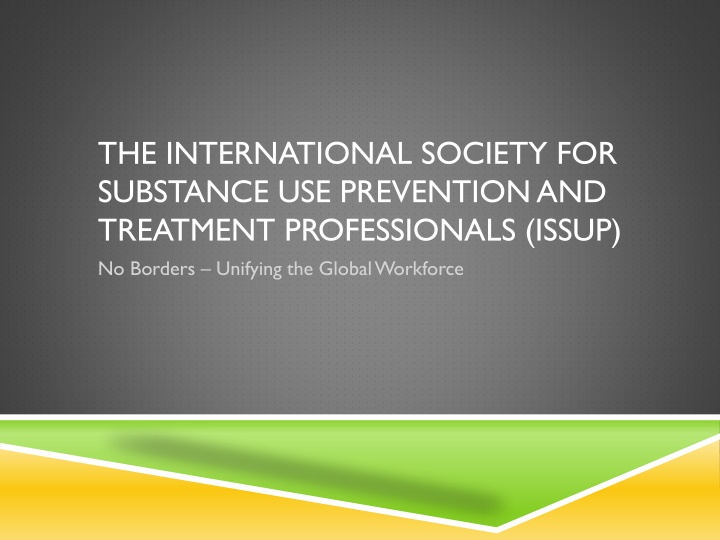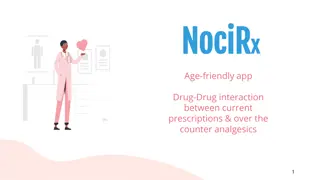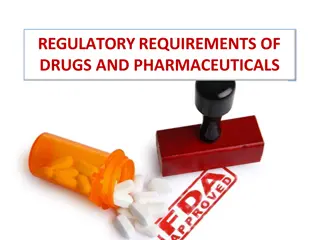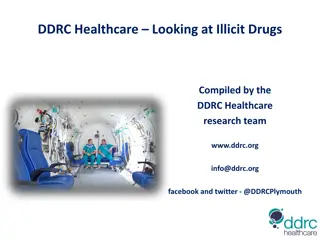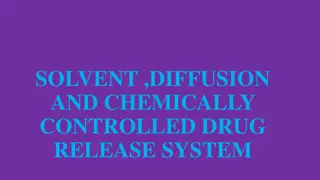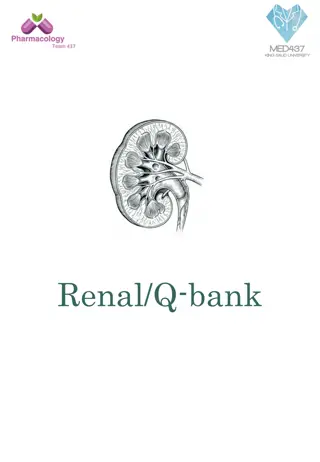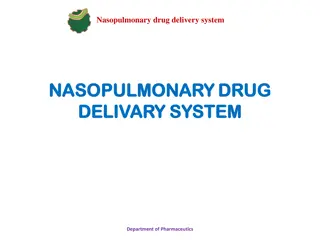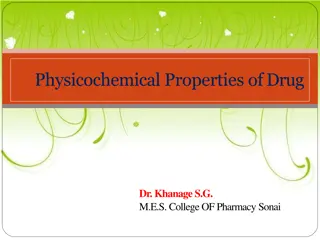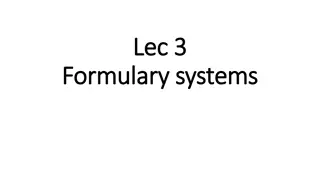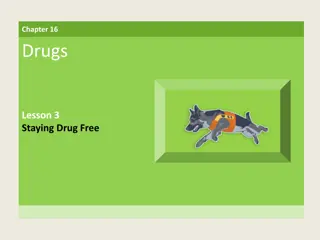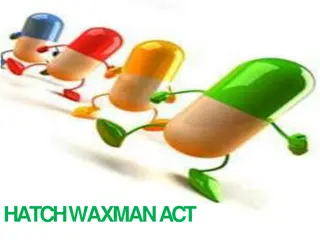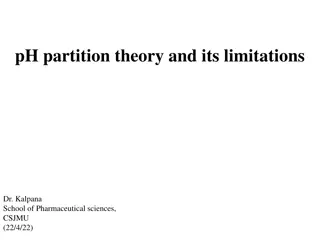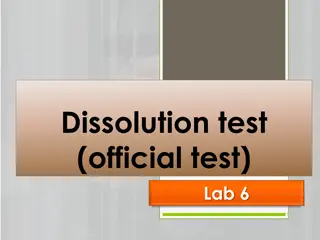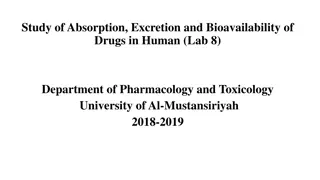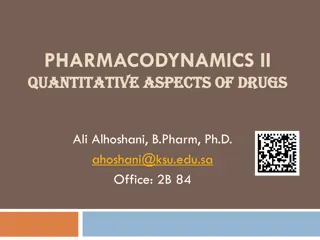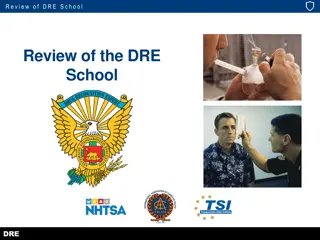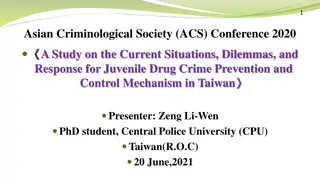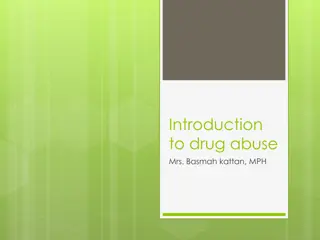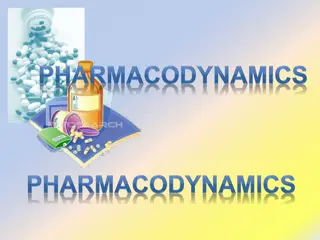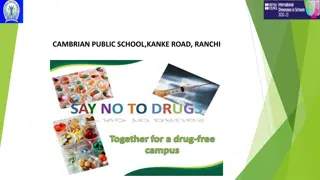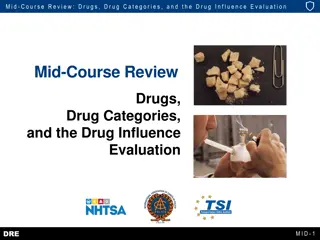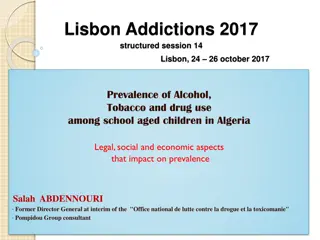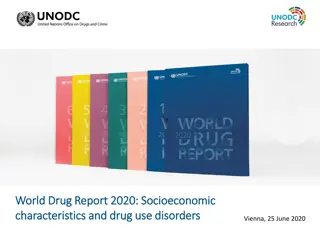Global Impact of Drug Use: Unifying Professionals
Science demonstrates the effectiveness of drug treatment and prevention in addressing global issues like terrorism, crime, and public health. The International Society for Substance Use Prevention and Treatment Professionals (ISSUP) aims to harness global expertise to combat transnational threats and promote evidence-based solutions. With significant advancements in research, drug addiction is recognized as a chronic disease requiring comprehensive interventions. Evidence from evaluations in Afghanistan and El Salvador highlights the positive impact of drug intervention programs on reducing drug use, crime rates, and suicide attempts.
Download Presentation

Please find below an Image/Link to download the presentation.
The content on the website is provided AS IS for your information and personal use only. It may not be sold, licensed, or shared on other websites without obtaining consent from the author.If you encounter any issues during the download, it is possible that the publisher has removed the file from their server.
You are allowed to download the files provided on this website for personal or commercial use, subject to the condition that they are used lawfully. All files are the property of their respective owners.
The content on the website is provided AS IS for your information and personal use only. It may not be sold, licensed, or shared on other websites without obtaining consent from the author.
E N D
Presentation Transcript
THE INTERNATIONAL SOCIETY FOR SUBSTANCE USE PREVENTION AND TREATMENT PROFESSIONALS (ISSUP) No Borders Unifying the Global Workforce
THE IMPACT OF DRUG USE Terrorism & Isurgency Organized Crime, Corruption, Money Laundering Public Security: Violence and Crime Communicable Diseases & Mental Health Drug Economic Development & Productivity Cultivation, Production, Trafficking Social Development of Children Governance
NO BORDERS Q. What do all of these threats share in common? A. They do not respect borders, sovereignty, and affect all nations.
NO BORDERS Transnational threats require transnational solutions. Today we launch the International Society of Substance Use Prevention and Treatment Professionals (ISSUP) to harness the global expertise in the fields of prevention and treatment, promote evidence-based research, and improve service delivery.
THE GOOD NEWS 70 years of scientific research in the field, with significant advances since 1990s. Innovations in behavioral and medical research Drug addiction is a chronic and relapsing disease (e.g. like diabetes, heart disease, hypertension) and its success rate is on par with these other conditions. U.S. Government (NIDA) conducts 85% of the world s research in the field of substance abuse treatment and prevention, spending billions of U.S. dollars over the past decades.
THE GOOD NEWS Science demonstrates that drug treatment and drug prevention work and have an impact beyond only drug use. Some results of INL outcome evaluations Afghanistan Evaluation Results: 31% decrease in opium overall 45% decrease for women (past 30-day use) 40% reduction in serious crime 48% reduction in non-serious crime 73% reduction in self-reported arrests (past month) 64% decrease in suicide attempts among women El Salvador Evaluation Results 70% reduction in drug use by gang members and non-gang members (gang members had higher use before treatment) 83% reduction in past-month felonies 75% reduction in arrests and incarcerations by gang members 66% reduction in arrests and incarcerations by non-gang members
THE BAD NEWS The scientific research is not being translated to the field. Addiction remains misunderstood by many and non-evidence- based practices continue to be used in some treatment programs. Non-evidence-based practices - Only detox, no psychosocial treatment - Religious education and work in isolation, no therapeutic interventions - Cold showers, physical restraints, beatings, starvation, and other techniques As a result of these practices, treatment fails; then clients, families, and communities lose hope for recovery and confidence in treatment.
ISSUP: GOALS, MISSION, AND VISION ISSUP is created with the purposes of: Better translating research into practice Recognizing substance use prevention and substance use treatment as independent and multidisciplinary fields of study and practice, requiring specialized academic and practical training. To serve as a professional association supported and guided by international organizations, donor partners, and organizing partners. ISSUP is not a policy forum to debate the merits of drug control policies. ISSUP members share a common aim to prevent and treat substance use. ISSUP does not aim to endorse one modality of treatment or a specific intervention above others. Simply, evidence-based interventions and research is shared and promoted. It is up to national authorities and prevention and treatment professionals to have a dialogue on how to strengthen their national treatment and prevention systems.
COMPONENTS OF ISSUP Connecting Researchers to Practitioners Promoting Evidence-Based Practices Research Scientific Sessions where researchers, university faculty, curriculum developers share knowledge about the field. Regular communication between researchers and practitioners via the ISSUP website. Greater dialogue between international associations of researcher and ISSUP members (e.g. NIDA, SPR, etc.).
COMPONENTS OF ISSUP Capacity Buiding Training of the Workforce Core Curricula Universal Treatment Curriculum (UTC) Universal Prevention Curriculum (UPC) Specialized Curricula Recovery Guiding the Recovery of Women (GROW) Child Substance Use Disorders Rural Treatment & Prevention Outreach Drop in Centers
COMPONENTS OF ISSUP Capacity Buiding Training of the Workforce 40+ countries will receive UTC, UPC, and specialized curriculum training in 2015. ISSUP promotes these training packages Other training packages by organizing partners are welcome. Other training packages shared by researchers/practitioners are welcomed. Expert Advisory Group will review and evaluate curricula before dissemination.
COMPONENTS OF ISSUP Capacity Buiding Examination and Credentialing Examination and Credentialing is a necessary process for the professionalization of the treatment and prevention field. ISSUP promotes the credentialing process. ICCE Credential ICCE Commission Meeting taking place during ISSUP. ICCE Credentialing Exam on Saturday Other international and national credentialing agencies are also welcome to join ISSUP and participate in ISSUP. Precondition: have reciprocity with the ICCE international credential
DIFFERENCE BETWEEN CERTIFICATION AND CREDENTIALING CERTIFICATION Undertake academic program Successful completion of coursework Earn an academic degree CREDENTIALING Demonstrate completion of a recognized academic program Demonstrate clinical/practical hours of experience Continuing education Take and pass a single exam Renew credential periodically
COMPONENTS OF ISSUP Registry of Professionals and Available Services Website for Regular Communication Communication www.ISSUP.net is a professional networking site Mapping of treatment and prevention services Directory of professionals in the field Documenting personal training history, credit hours received ISSUP registration numbers are generated for anyone trained in these curricula Ability for those professionals to communicate with one another: Through the Forum By sharing research and news articles Announce upcoming and documenting past training events
SUMMARY: COMPONENTS OF ISSUP Promoting Evidence- Based Practices Connecting Researchers to Practitioners Research Capacity Buiding Training of the Workforce Examination and Credentialing Communication Website for Regular Communication Registry of Professionals and Available Services
ISSUP GROUPS ISSUP MEMBER TITLES 1. Non-credentialed trainees and meeting participants PARTICIPANT Trainees credentialed at: 2. Basic level 3. Intermediate level 4. Advanced level 5. ISSUP volunteers (e.g. website moderators) 6. National Trainer 7. Master Trainer (Regional and Global) TRAINER
ISSUP MEMBER TITLES ISSUP GROUPS BOARD MEMBER 8. Executive Management Board 9. Curriculum Developers DEVELOPER 9. Researcher / Investigator RESEARCHER 9. Representative to the Credentialing Agency COMMISSIONER
ISSUP MEMBER TITLES ISSUP GROUPS 10. Treatment Expert Advisory Group (TEAG) 10. Prevention Expert Advisory Group (PEAG) EXPERT 10. Organizing Committee Members - International Organizations - Donor Governments - Local Partners (Govt & civil society) COMMITTEE
ISSUPS GOVERNING BODY BOARD MEMBER 8. Executive Management Board Election will take place at ISSUP-III (2017) to establish an independent governing board comprised of ISSUP members. Board will be geographically representative Board will meet between ISSUP conferences In the interim (2015-2017), a Pro Tem Committee comprised of the organizing partners and select members will take responsibility for the development of ISSUP. Group will meet to form this Committee on Wednesday evening
ISSUP ANNUAL MEETINGS The primary interaction between members is the website. The primary opportunity for training and credentialing are trainings and exams conducted in your countries. Long term vision: Online trainings Annual ISSUP workshops are designed for: Current and prospective members to meet. Organizers to share future activities and opportunities (Plenary Day) Researchers/developers to share the latest research (Scientific Session) Training and Credentialing Examination Opportunities (Day 2-6) Expert Advisory Group Meetings and Commission Meetings (Day 2-4) Other special meetings (Afghanistan Stakeholders, Central Asia Curriculum Expert Working Group)
ISSUP ANNUAL MEETINGS Primary Geographic Regions Annual meetings occur in a different region of the world to allow for more participants from those regions to attend. North America Including Central America & the Caribbean South America Europe Africa Asia Including the Middle East Australia/Oceania Additional criteria is the opportunity to partner with a related event that is aligned with ISSUP s vision, mission and goals.
QUESTIONS & ANSWERS Q. How do I join ISSUP? A. Register on the website and set up a profile. Having an account on the website will constitute membership for now. Q. What are the membership dues? Is there a fee to join? A. Not yet. The Pro Tem Committee will discuss this question on Wednesday. Q. Can I join ISSUP without registering on the website? A. No. Registration is required.
QUESTIONS & ANSWERS Q. Can I receive the UTC/UPC training or ICCE credential without joining ISSUP? Yes, but your training history needs to be documented by the trainers on the ISSUP website (visible only to ICCE) for the purpose of determining eligibility for the exam. Q. Do I need to earn a credential to remain part of ISSUP? A. No, but credentialing is encouraged and we are trying to encourage governments to recognize and require credentialing in the fields of treatment and prevention. Q. Can I get a copy of this brilliant presentation? A. Yes, all plenary presentations will be posted on the ISSUP website so register today!
